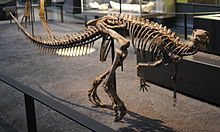Ornithopod
| Ornithopods Temporal range: Middle Jurassic - Late Cretaceous, 163–66 Ma PreЄ Є O S D C P T J K Pg N | |
|---|---|
 | |
| Mounted skeleton of Parasaurolophus cyrtocristatus, Field Museum of Natural History | |
Scientific classification | |
| Kingdom: | Animalia |
| Phylum: | Chordata |
Clade: | Dinosauria |
| Order: | †Ornithischia |
Clade: | †Cerapoda |
| Suborder: | †Ornithopoda Marsh, 1881 |
| Subgroups | |
| |
Ornithopods (/ɔːrˈnɪθəˌpɒdz, ˈɔːrnɪ-/[1][2]) or members of the clade Ornithopoda (/ˌɔːrnɪˈθɒpədə/ or /ɔːrˌnɪθəˈpoʊdə, ˌɔːrnɪ-/[3]) are a group of ornithischian dinosaurs that started out as small, bipedal running grazers, and grew in size and numbers until they became one of the most successful groups of herbivores in the Cretaceous world, and dominated the North American landscape. Their major evolutionary advantage was the progressive development of a chewing apparatus that became the most sophisticated ever developed by a non-avian dinosaur, rivaling that of modern mammals such as the domestic cow. They reached their apex in the duck-bills (hadrosaurs), before they were wiped out by the Cretaceous–Paleogene extinction event along with all other non-avian dinosaurs. Members are known from all seven continents, though they are generally rare in the Southern Hemisphere.
Contents
1 Description
2 Classification
2.1 Taxonomy
2.2 Phylogeny
3 References
4 External links
Description

Three-toed feet of Iguanodon
Ornithopoda means "bird feet", from the Greek ornithos ("bird") and pous ("feet"); this refers to their characteristic three-toed feet, although many early forms retained four toes. They were also characterized by having no armour, the development of a horny beak, an elongated pubis that eventually extended past the ilium, and a missing hole in the lower jaw. A variety of ornithopods and related cerapods had thin cartilaginous plates along the outside of the ribs; in some cases, these plates mineralized and were fossilized. The function of these intercostal plates is unknown. They have been found with Hypsilophodon, Othnielosaurus, Parksosaurus, Talenkauen, Thescelosaurus,[4] and Macrogryphosaurus to date.[5]

Size of a variety of iguanodontian ornithopods
The early ornithopods were only about 1 metre (3 feet) long, but probably very fast. They had a stiff tail, like the theropods, to help them balance as they ran on their hind legs. Later ornithopods became more adapted to grazing on all fours; their spines curved, and came to resemble the spines of modern ground-feeders such as the bison. As they became more adapted to eating while bent over, they became facultative quadrupeds; still running on two legs, and comfortable reaching up into trees; but spending most of their time walking or grazing while on all fours. The taxonomy of dinosaurs previously ascribed to the Hypsilophodontidae is problematic. The group previously consisted of all non-iguanodontian bipedal ornithischians, but a phylogenetic reappraisal has shown such species to be paraphyletic. As such, the hypsilophodont family is currently represented only by Hypsilophodon.[6]
Later ornithopods became larger, but never rivalled the incredible size of the long-necked, long-tailed sauropods that they partially supplanted. The very largest, such as Shantungosaurus, were as heavy as medium-sized sauropods at up to 23 metric tons (25 short tons) but never grew much beyond 15 metres (50 feet).
Classification

An artist's interpretation of Gideonmantellia, sometimes considered one of the most primitive ornithopods

Restoration of Muttaburrasaurus, an early iguanodont

Skeleton of Dysalotosaurus, a dryosaurid ornithopod from the Jurassic

Life restoration of Iguanacolossus, an early styracosternan

Reconstruction of Mantellisaurus, a primitive member of the Hadrosauriformes

Mounted skeleton of Edmontosaurus, a saurolophine hadrosaur, and one of the last ornithopods
Historically, most indeterminate ornithischian bipeds were lumped in as ornithopods. Most have since been reclassified.[citation needed]
Taxonomy
Ornithopoda is usually given the rank of Suborder, within the order Ornithischia. While ranked taxonomy has largely fallen out of favour among dinosaur paleontologists, some researchers have continued to employ such a classification, though sources have differed on what its rank should be. Benton (2004) placed it as an infraorder within the suborder Cerapoda (originally named as an unranked clade), while others, such as Ibiricu et al. 2010, have retained it at its traditional ranking of suborder.[7]
Phylogeny
The cladogram below follows a 2017 analysis by Madzia et al.:[8]
.mw-parser-output table.cladeborder-spacing:0;margin:0;font-size:100%;line-height:100%;border-collapse:separate;width:auto.mw-parser-output table.clade table.cladewidth:100%.mw-parser-output table.clade tdborder:0;padding:0;vertical-align:middle;text-align:center.mw-parser-output table.clade td.clade-labelwidth:0.8em;border:0;padding:0 0.2em;vertical-align:bottom;text-align:center.mw-parser-output table.clade td.clade-slabelborder:0;padding:0 0.2em;vertical-align:top;text-align:center.mw-parser-output table.clade td.clade-barvertical-align:middle;text-align:left;padding:0 0.5em.mw-parser-output table.clade td.clade-leafborder:0;padding:0;text-align:left;vertical-align:middle.mw-parser-output table.clade td.clade-leafRborder:0;padding:0;text-align:right
Clypeodonta |
| ||||||||||||||||||||||||||||||||||||||||||||||||||||||||||||||||||
| |
References
^ "ornithopod - definition of ornithopod in English from the Oxford dictionary". OxfordDictionaries.com. Retrieved 2016-01-20..mw-parser-output cite.citationfont-style:inherit.mw-parser-output .citation qquotes:"""""""'""'".mw-parser-output .citation .cs1-lock-free abackground:url("//upload.wikimedia.org/wikipedia/commons/thumb/6/65/Lock-green.svg/9px-Lock-green.svg.png")no-repeat;background-position:right .1em center.mw-parser-output .citation .cs1-lock-limited a,.mw-parser-output .citation .cs1-lock-registration abackground:url("//upload.wikimedia.org/wikipedia/commons/thumb/d/d6/Lock-gray-alt-2.svg/9px-Lock-gray-alt-2.svg.png")no-repeat;background-position:right .1em center.mw-parser-output .citation .cs1-lock-subscription abackground:url("//upload.wikimedia.org/wikipedia/commons/thumb/a/aa/Lock-red-alt-2.svg/9px-Lock-red-alt-2.svg.png")no-repeat;background-position:right .1em center.mw-parser-output .cs1-subscription,.mw-parser-output .cs1-registrationcolor:#555.mw-parser-output .cs1-subscription span,.mw-parser-output .cs1-registration spanborder-bottom:1px dotted;cursor:help.mw-parser-output .cs1-ws-icon abackground:url("//upload.wikimedia.org/wikipedia/commons/thumb/4/4c/Wikisource-logo.svg/12px-Wikisource-logo.svg.png")no-repeat;background-position:right .1em center.mw-parser-output code.cs1-codecolor:inherit;background:inherit;border:inherit;padding:inherit.mw-parser-output .cs1-hidden-errordisplay:none;font-size:100%.mw-parser-output .cs1-visible-errorfont-size:100%.mw-parser-output .cs1-maintdisplay:none;color:#33aa33;margin-left:0.3em.mw-parser-output .cs1-subscription,.mw-parser-output .cs1-registration,.mw-parser-output .cs1-formatfont-size:95%.mw-parser-output .cs1-kern-left,.mw-parser-output .cs1-kern-wl-leftpadding-left:0.2em.mw-parser-output .cs1-kern-right,.mw-parser-output .cs1-kern-wl-rightpadding-right:0.2em
^ "Ornithopod". Merriam-Webster Dictionary.
^ See analogous pronunciation of "gastropoda - definition of gastropoda in English from the Oxford dictionary". OxfordDictionaries.com. Retrieved 2016-01-20.
^ Butler, Richard J.; Galton, Peter M. (August 2008). "The 'dermal armour' of the ornithopod dinosaur Hypsilophodon from the Wealden (Early Cretaceous: Barremian) of the Isle of Wight: a reappraisal". Cretaceous Research. 29 (4): 636–642. doi:10.1016/j.cretres.2008.02.002.
^ Calvo, J. O.; Porfiri, J. D.; Novas, F. E. (2007). "Discovery of a new ornithopod dinosaur from the Portezuelo Formation (Upper Cretaceous), Neuquén, Patagonia, Argentina". Arquivos do Museu Nacional. 65 (4): 471–483.
^ Weishampel, D. B. & Heinrich, R. E. (1992). "Systematics of Hypsilophodontidae and basal Iguanodontia (Dinosauria: Ornithopoda)". Historical Biology. 6 (3): 159–184. doi:10.1080/10292389209380426.
^ Ibiricu, L. M.; Martínez, R. D.; Lamanna, M. C.; Casal, G. A.; Luna, M.; Harris, J. D. and Lacovara, K. J. (2010). "A Medium-Sized Ornithopod (Dinosauria: Ornithischia) from the Upper Cretaceous Bajo Barreal Formation of Lago Colhué Huapi, Southern Chubut Province, Argentina." Annals of Carnegie Museum, 79(1): 39-50. doi:10.2992/007.079.0103
^ Madzia, Daniel; Boyd, Clint A.; Mazuch, Martin (2017). "A basal ornithopod dinosaur from the Cenomanian of the Czech Republic". Journal of Systematic Palaeontology: 1–13. doi:10.1080/14772019.2017.1371258.
External links
GEOL 104 dinosaurs: a Natural history, ornithopoda: beaks, bills & crests, by Thomas R. Holtz, Jr.











